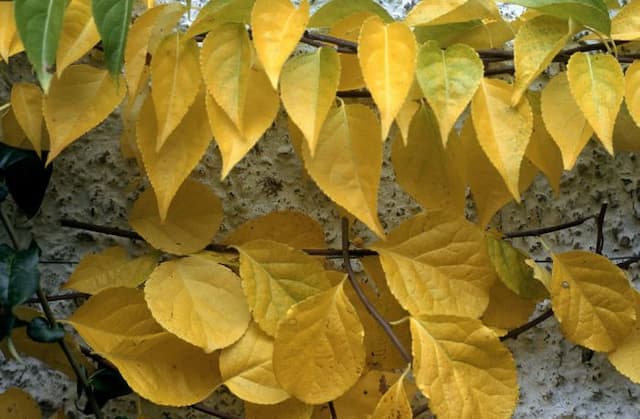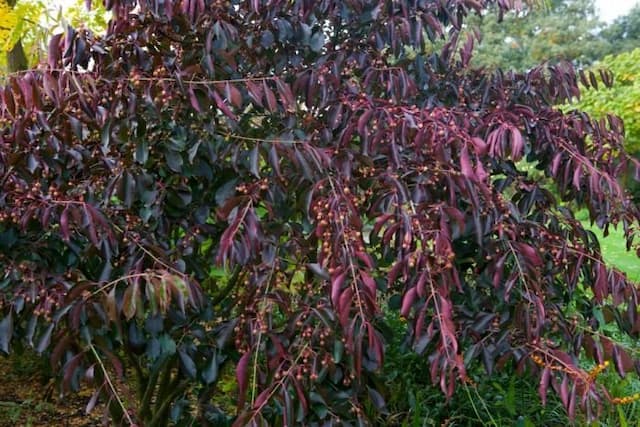European spindle Euonymus europaeus 'Red Cascade'

ABOUT
The 'Red Cascade' is a captivating ornamental shrub known for its striking appearance through various seasons. Initially, in the spring and summer, it is adorned with oval-shaped leaves that are a glossy green color, providing a lush and dense foliage. As the seasons transition from summer to fall, the leaves undergo a dramatic change, turning a vibrant shade of red to purple. This fall coloration is one of the hallmark features of 'Red Cascade', making it a popular choice for gardeners seeking a splash of autumnal color in their landscapes. The plant is not only acclaimed for its foliage but also for its decorative fruit. During the fall, it produces a profusion of pinkish-red, capsule-like fruits which split open to reveal bright orange seeds that dangle from the branches, adding to the visual appeal. Additionally, 'Red Cascade' is characterized by its distinctive stem structure, with branches that form a somewhat sprawling habit, contributing to the plant's overall ornamental quality. Throughout the year, the 'Red Cascade' provides interest and beauty, making it a versatile and attractive addition to gardens and outdoor spaces.
About this plant
 Names
NamesFamily
Celastraceae.
Synonyms
European Spindle, Spindle Tree, European Spindletree, Common Spindle.
Common names
Euonymus europaeus 'Red Cascade'.
 Toxicity
ToxicityTo humans
The plant commonly known as Spindle Tree contains toxic compounds that can be harmful if ingested. The seeds, leaves, and other parts of the plant are poisonous and can cause symptoms such as nausea, vomiting, diarrhea, weakness, chills, and in severe cases, can affect the heart and lead to convulsions or coma. It is advisable to seek medical attention immediately if any part of the Spindle Tree is ingested.
To pets
The Spindle Tree is toxic to pets as it is to humans. If pets consume any part of the plant, they could experience vomiting, diarrhea, weakness, and abdominal pain. More severe symptoms could include cardiac problems, muscle tremors, and in extreme cases, seizures or coma. If a pet is suspected to have ingested Spindle Tree, it is crucial to seek veterinary care promptly.
 Characteristics
CharacteristicsLife cycle
Perennials
Foliage type
Deciduous
Color of leaves
Green
Flower color
Greenish-white
Height
10-15 feet (3-4.5 meters)
Spread
8-10 feet (2.4-3 meters)
Plant type
Shrub
Hardiness zones
4-7
Native area
Europe
Benefits
 General Benefits
General Benefits- Ornamental Appeal: Euonymus europaeus 'Red Cascade', commonly known as the European spindle, features eye-catching foliage that turns vivid red in the fall and attractive pinkish-red fruits with orange seeds.
- Wildlife Habitat: The plant provides food for birds and other wildlife with its fruits, contributing to biodiversity in the garden.
- Low Maintenance: It requires minimal care once established, making it suitable for gardeners with limited time.
- Drought Tolerance: Once mature, the European spindle can tolerate periods of drought, reducing the need for frequent watering.
- Cold Hardy: The plant is resilient to cold temperatures and can survive in cold climates without special protection.
- Adaptable Growth: It can grow in a variety of soil types, from clay to sandy soils, as long as the drainage is good.
- Privacy Screening: With its dense growth habit, it can be used for hedges or privacy screens in landscaping.
- Soil Erosion Control: It helps in stabilizing soil and preventing erosion, especially on slopes due to its extensive root system.
 Medical Properties
Medical PropertiesThis plant is not used for medical purposes.
 Air-purifying Qualities
Air-purifying QualitiesThis plant is not specifically known for air purifying qualities.
 Other Uses
Other Uses- Dye Production: The fruits of the Spindle Tree can be used to create a yellow dye for textiles.
- Decorations: Branches with brightly colored fruit are often used in floral arrangements and wreaths during autumn and winter seasons.
- Wildlife Shelter: The dense foliage provides shelter for birds and small mammals throughout the year.
- Woodcraft: The hard, dense wood is traditionally used for making small objects such as tool handles and spindles for spinning wool – giving the tree its common name.
- Hedging: The Spindle Tree can be pruned to form dense hedges that provide both privacy and a windbreak for gardens and farmland.
- Winter Interest: Its persistent fruit capsules and vibrant autumn foliage add visual interest to a garden during the bleak winter months.
- Soil Improvement: Because it's a native species, planting the Spindle Tree can help maintain local soil conditions and biodiversity.
- Berries for Ink: The fruits can be used to make a pinkish ink for art or craft projects.
- Bonsai: Some garden enthusiasts use Spindle Tree to create bonsai for its interesting foliage and fruit.
- Educational Tool: The distinct features of the Spindle Tree can be used to educate students and nature enthusiasts about native plant species, seasonal changes, and wildlife dependencies.
Interesting Facts
 Feng Shui
Feng ShuiThe Spindle is not used in Feng Shui practice.
 Zodiac Sign Compitability
Zodiac Sign CompitabilityThe Spindle is not used in astrology practice.
 Plant Symbolism
Plant Symbolism- Fortune and Prosperity: The common name of Euonymus europaeus 'Red Cascade' is "Spindle" and it is often associated with fortune because of the plant's lush and vibrant appearance that resembles growth and abundance.
- Protection: Historically, the wood of the Spindle tree was used to make spindles for spinning wool, an essential household task. This association with daily life and work gave rise to the belief in the plant’s protective qualities, guarding against misfortune.
- Safe Travel: Spindle trees were sometimes planted near homes as a charm for protection, which extended to travelers. It symbolized the safe journey and return of those who ventured away from home.
 Water
WaterEuropean spindle 'Red Cascade' requires consistent moisture but does not like to be waterlogged. It should be watered deeply once a week, with about 1 to 1.5 gallons of water, allowing the soil to dry out slightly between waterings. During hot or dry periods, check the soil more frequently and water as needed to prevent stress. In cooler or rainy seasons, reduce the frequency to prevent overwatering. Always adjust the watering schedule based on weather conditions, the plant's growth stage, and the specific microclimate of your garden.
 Light
LightEuropean spindle 'Red Cascade' thrives best in full sun to partial shade. Ideally, plant it in a location where it receives at least four to six hours of direct sunlight each day for optimal growth and foliage development. However, it can tolerate some shade, especially during the hottest part of the day, which can help protect the leaves from scorching.
 Temperature
TemperatureEuropean spindle 'Red Cascade' is hardy and can withstand a wide range of temperatures. It is comfortable in temperatures as low as -30 degrees Fahrenheit and as high as 90 degrees Fahrenheit, but the ideal temperature range is between 60 and 80 degrees Fahrenheit. Ensure that the plant is not exposed to extreme cold without protection, especially in the northern limits of its hardiness zone.
 Pruning
PruningPrune European spindle 'Red Cascade' to maintain its shape and encourage healthy growth. The best time for pruning is late winter or early spring before new growth begins. Prune selectively to remove any dead or damaged branches and to shape the plant as desired. Pruning can be performed annually or as needed to control the size of the plant and to encourage a strong structure.
 Cleaning
CleaningAs needed
 Soil
SoilEuropean Spindle 'Red Cascade' thrives in well-drained, loamy soil enriched with organic matter. The ideal pH for this plant is between 6.0 and 7.5, slightly acidic to neutral. A soil mix containing equal parts garden soil, compost, and peat or leaf mold is optimal to ensure good growth and vibrant foliage.
 Repotting
RepottingEuropean Spindle 'Red Cascade' is typically grown as an outdoor shrub and does not require frequent repotting. It should be transplanted only if it outgrows its current location or if the soil conditions need rejuvenation, which may be every few years.
 Humidity & Misting
Humidity & MistingEuropean Spindle 'Red Cascade' is tolerant of a wide range of humidity levels as it is mainly an outdoor plant. However, it tends to thrive best in moderate humidity conditions that resemble its natural habitat.
 Suitable locations
Suitable locationsIndoor
Place in bright, indirect light and keep soil lightly moist.
Outdoor
Plant in well-drained soil, full sun to part shade; mulch roots.
Hardiness zone
4-9 USDA
 Life cycle
Life cycleThe European spindle 'Red Cascade' begins its life as a seed, typically dispersed by birds attracted to its fruit. Germination follows a period of dormancy, which can be broken by cold stratification, mimicking natural winter conditions. Once germinated, the seedling establishes itself, growing slowly at first and then more rapidly, forming a multi-stemmed shrub. As it matures, it develops distinctive greenish-yellow flowers in the spring, which are followed by a summer growth of leaves. Autumn heralds its most striking feature when the leaves turn a fiery red and orange, and the pink-red fruits open to reveal orange seeds. The plant then enters dormancy in winter, conserving energy to repeat the cycle in spring.
 Propogation
PropogationPropogation time
Summer to Autumn
The most popular method of propagation for the European spindle tree 'Red Cascade' is through seed sowing. Seeds require a period of cold stratification to break dormancy before they will germinate. This process involves mixing the seeds with a moist substrate, such as sand or peat, and then chilling them in a refrigerator for approximately 10-12 weeks. After cold stratification, the seeds are sown in containers or a prepared seedbed in spring. It is important to keep the soil moist but not waterlogged. Seedlings can take several years to reach a sufficient size for transplanting into their permanent positions.







